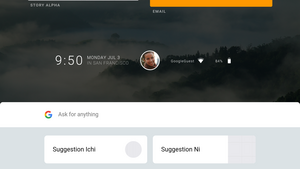Fuchsia (operating system): Difference between revisions
ChristianKl (talk | contribs) →Zircon: The quote is from Forbes and not from Google |
Removed second equal sign. Tags: Mobile edit Mobile web edit |
||
| Line 37: | Line 37: | ||
| other articles = |
| other articles = |
||
}} |
}} |
||
'''Fuchsia''' is an [[open source]] [[capability-based security|capability-based]] [[operating system]] currently being developed by [[Google]]. It first became known to the public when the project appeared on a self hosted form of [[git]] in August 2016 without any official announcement. The source documentation describes the reasoning behind the name as "Pink + Purple |
'''Fuchsia''' is an [[open source]] [[capability-based security|capability-based]] [[operating system]] currently being developed by [[Google]]. It first became known to the public when the project appeared on a self hosted form of [[git]] in August 2016 without any official announcement. The source documentation describes the reasoning behind the name as "Pink + Purple = Fuchsia (a new Operating System)".<ref>{{cite web|url=https://fuchsia.dev/fuchsia-src/getting_started.md|title=Fuchsia}}</ref> In contrast to prior Google-developed operating systems such as [[Chrome OS]] and [[Android (operating system)|Android]], which are based on the [[Linux kernel]], Fuchsia is based on a new [[microkernel]] called Zircon, named after [[Zircon|the mineral]]. |
||
The GitHub project suggests Fuchsia can run on many platforms, from [[embedded systems]] to [[smartphone]]s, [[Tablet computer|tablets]], and [[personal computer]]s. In May 2017, Fuchsia was updated with a [[user interface]], along with a developer writing that the project was not a "dumping ground of a dead thing", prompting media speculation about Google's intentions with the operating system, including the possibility of it replacing Android. On July 1, 2019 Google announced the homepage of the project, [http://fuchsia.dev fuchsia.dev], which provides [[source code]] and [[documentation]] for the newly announced operating system.<ref>{{Cite web|url=https://lwn.net/Articles/792465/rss|title=Google's Fuchsia OS Developer Site Debuts (Forbes)}}</ref> |
The GitHub project suggests Fuchsia can run on many platforms, from [[embedded systems]] to [[smartphone]]s, [[Tablet computer|tablets]], and [[personal computer]]s. In May 2017, Fuchsia was updated with a [[user interface]], along with a developer writing that the project was not a "dumping ground of a dead thing", prompting media speculation about Google's intentions with the operating system, including the possibility of it replacing Android. On July 1, 2019 Google announced the homepage of the project, [http://fuchsia.dev fuchsia.dev], which provides [[source code]] and [[documentation]] for the newly announced operating system.<ref>{{Cite web|url=https://lwn.net/Articles/792465/rss|title=Google's Fuchsia OS Developer Site Debuts (Forbes)}}</ref> |
||
Revision as of 23:20, 12 August 2019
 | |
 Screenshot of the Armadillo user shell, part of Fuchsia | |
| Developer | |
|---|---|
| Written in | C, C++, Dart, Go, Rust |
| OS family | Zircon |
| Working state | Current |
| Source model | Open source |
| Initial release | 15 August 2016 |
| Repository | |
| Available in | English |
| Platforms | ARM64, x86-64 |
| Kernel type | Microkernel |
| Default user interface | Armadillo |
| License | BSD, MIT, Apache License 2.0 |
| Official website | fuchsia |
Fuchsia is an open source capability-based operating system currently being developed by Google. It first became known to the public when the project appeared on a self hosted form of git in August 2016 without any official announcement. The source documentation describes the reasoning behind the name as "Pink + Purple = Fuchsia (a new Operating System)".[1] In contrast to prior Google-developed operating systems such as Chrome OS and Android, which are based on the Linux kernel, Fuchsia is based on a new microkernel called Zircon, named after the mineral.
The GitHub project suggests Fuchsia can run on many platforms, from embedded systems to smartphones, tablets, and personal computers. In May 2017, Fuchsia was updated with a user interface, along with a developer writing that the project was not a "dumping ground of a dead thing", prompting media speculation about Google's intentions with the operating system, including the possibility of it replacing Android. On July 1, 2019 Google announced the homepage of the project, fuchsia.dev, which provides source code and documentation for the newly announced operating system.[2]
History
In August 2016, media outlets reported on a mysterious codebase post published on GitHub, that revealed that Google was developing a new operating system called "Fuchsia". While no official announcement was made, inspection of the code suggested its capability to run on universal devices, including "dash infotainment systems for cars, to embedded devices like traffic lights and digital watches, all the way up to smartphones, tablets and PCs". The code differs from Android and Chrome OS due to its being based on the Zircon kernel (formerly called Magenta)[3] rather than on the Linux kernel.[4][5][6]
In May 2017, Ars Technica wrote about Fuchsia's new user interface, an upgrade from its command-line interface at its first reveal in August, along with a developer writing that Fuchsia "isn't a toy thing, it's not a 20% Project, it's not a dumping ground of a dead thing that we don't care about anymore".[7] Multiple media outlets wrote about the project's seemingly close ties to Android, with some speculating that Fuchsia might be an effort to "re-do"[8] or replace Android[9][10][11] in a way that fixes problems on that platform.[7]
In November 2017, initial support for the Swift programming language was committed.[12]
In January 2018, Google published a guide on how to run Fuchsia on Pixelbooks.[13][14] This was done successfully by Ars Technica.[15]
In October 2018, it was reported that the recently announced Google Home Hub may be a known Fuchsia OS test device, code named "Astro".[16]
In January 2019, a Fuchsia "device" was added to Android.[17][18]
In May 2019, Google talked about Fuchsia at Google I/O 2019.[19]
On July 1, 2019 Google announced the homepage of the project, fuchsia.dev, which provides source code and documentation for the newly announced operating system.[20]
Features
Fuchsia's user interface and apps are written with Flutter, a software development kit allowing cross-platform development abilities for Fuchsia, Android and iOS. Flutter produces apps based on Dart, offering apps with high performance that run at 120 frames per second. Flutter also offers a Vulkan-based graphics rendering engine called Escher, with specific support for "Volumetric soft shadows", an element that Ars Technica wrote "seems custom-built to run Google's shadow-heavy 'Material Design' interface guidelines".
Due to the Flutter software development kit offering cross-platform opportunities, users are able to install parts of Fuchsia on Android devices. Ars Technica noted that, while users could test Fuchsia, nothing "works", adding that "it's all a bunch of placeholder interfaces that don't do anything", though finding multiple similarities between Fuchsia's interface and Android, including a Recent Apps screen, a Settings menu, and a split-screen view for viewing multiple apps at once.[7]
After the second review, Ars Technica experts were impressed with the progress, noting that things were then working, and were especially pleased by the hardware support. One of the positive surprises was the support for multiple mouse pointers.[15]
A special version of Android Runtime for Fuchsia will be developed. It will run on machines with this system from a FAR file, the equivalent of the Android APK.[21]
Zircon
Fuchsia is based on a new microkernel called Zircon. Zircon is derived from Little Kernel,[22][23][24] a small operating system intended for embedded systems. "Little Kernel" was developed by Travis Geiselbrecht, a creator of the NewOS kernel used by Haiku.[25][26] Forbes describes the evolution of Zircon as
"Zircon was previously known as Magenta and it was designed to scale to any application from embedded RTOS (Real-Time Operating Systems) to mobile and desktop devices of all kinds. As a result, there has been much speculation that Fuchsia will be the natural successor to Android and Chrome OS, combining capabilities of both with backwards compatibility to run legacy applications built on either. In short, this thing is designed to run on anything from 32-bit or 64-bit ARM cores to 64-bit X86 processors and it has a potential to be rather disruptive."[27]
The software documentation of the Zircon microkernel outlines the technical specifications. Zircon is the basis for the Fuchsia OS. Zircon comprises a microkernel (source in kernel/...) and userspace services, drivers, and libraries (source in system/...) as part of the boot process as well as talk to hardware. Zircon provides more than 100 syscalls. Zircon syscalls are generally non-blocking with the wait_one, wait_many port_wait and thread sleep being the notable exceptions.[28]
See also
References
- ^ "Fuchsia".
- ^ "Google's Fuchsia OS Developer Site Debuts (Forbes)".
- ^ McGrath, Roland (12 September 2017). "[zx] Magenta -> Zircon". zircon - Git at Google. Retrieved 19 September 2017.
- ^ Etherington, Darrell (August 15, 2016). "Google's mysterious new Fuchsia operating system could run on almost anything". TechCrunch. AOL. Retrieved October 5, 2016.
- ^ Fingas, Jon (August 13, 2016). "Google's Fuchsia operating system runs on virtually anything". Engadget. AOL. Retrieved October 5, 2016.
- ^ Szász, Attila (November 8, 2017). "Dive into Magenta – fuzzing Google's new kernel". YouTube. Hacktivity.
- ^ a b c Amadeo, Ron (May 8, 2017). "Google's "Fuchsia" smartphone OS dumps Linux, has a wild new UI". Ars Technica. Condé Nast. Retrieved May 9, 2017.
- ^ Fingas, Jon (May 8, 2017). "Google's mysterious Fuchsia OS looks like an Android re-do". Engadget. AOL. Retrieved May 9, 2017.
- ^ Gartenberg, Chaim (May 8, 2017). "Google's mysterious new Fuchsia OS has a UI now". The Verge. Vox Media. Retrieved May 9, 2017.
- ^ Davenport, Corbin (May 8, 2017). "Google's "Fuchsia" operating system is taking shape with a new design". Android Police. Retrieved May 9, 2017.
- ^ "First Look at all new Fuchsia OS from Google". IB Computing. IB Computing. January 18, 2018. Retrieved January 18, 2018.
- ^ "Add Fuchsia OS support". GitHub PR for Swift. 2017-11-15.
- ^ "Yes, Google Is Running Fuchsia On The Pixelbook: Calm Down". Chrome Unboxed - The Latest Chrome OS News. 2018-01-01. Retrieved 2018-01-03.
- ^ Contribute to docs development by creating an account on GitHub, Fuchsia, 2018-01-03, retrieved 2018-01-03
- ^ a b Amadeo, Ron (8 January 2018). "Google's Fuchsia OS on the Pixelbook: It works! It actually works!". Ars Technica. Condé Nast. Retrieved 22 January 2018.
Right now, Google's built-from-scratch kernel and operating system will actually boot on the Pixelbook, and some things even work. The touchscreen, trackpad, and keyboard work and so do the USB ports. You can even plug in a mouse and get a second mouse cursor.
- ^ Bradshaw, Kyle (2018-10-10). "The newly-launched Google Home Hub is 'Astro,' a known Fuchsia OS test device". 9to5Google. Retrieved 2018-10-12.
- ^ "Add initial fuchsia target". 2019-01-22.
- ^ Bradshaw, Kyle (2019-01-03). "Google's Fuchsia OS confirmed to have Android app support via Android Runtime". 9to5Google. Retrieved 2019-01-04.
- ^ https://9to5google.com/2019/05/09/what-is-google-fuchsia/
- ^ "Google's Fuchsia OS Developer Site Debuts (Forbes)".
- ^ "Google's Fuchsia OS confirmed to have Android app support via Android Runtime". 9to5Google. 2019-01-03. Retrieved 2019-03-27.
- ^ https://github.com/littlekernel/lk
- ^ Sims, Gary (August 17, 2016). "What we learned from running Fuchsia, the mysterious new OS from Google". Android Authority. Retrieved May 9, 2017.
- ^ Mahate, Shakeel (October 24, 2016). "Introduction". GitHub. Retrieved May 9, 2017.
- ^ "Travis Geiselbrecht (Projects section)". October 24, 2016. Retrieved Nov 21, 2017.
- ^ "Travis Geiselbrecht – Staff Software Engineer – Greater Seattle Area". linkedin.com. Retrieved 2018-11-26.
- ^ "Google's Fuchsia OS Developer Site Debuts (Forbes)".
- ^ "Zircon".
External links
- Capability systems
- Embedded operating systems
- Free software operating systems
- Software using the BSD license
- Software using the MIT license
- Software using the Apache license
- Google operating systems
- Google software
- Microkernel-based operating systems
- Real-time operating systems
- Upcoming software
- X86-64 operating systems
- Free software programmed in C
- C++ software
- Go software
- Software programmed in Rust
- Microkernels
- Operating system stubs
